Watering spider plants correctly is key to keeping them healthy and looking their best. They need a steady supply of moisture, but don’t like to be over or under watered.
In this post, I’m going to explain how to tell when it’s time to water your spider (aka airplane) plant, and give you step-by-step instructions for properly hydrating it.
Then I’ll show you the best techniques and what type of water to use on your spider plant, and how to get the balance perfect every time.

Spider Plant Watering Requirements
Spider plants require consistent moisture, but it’s important not to over or under water them.
If you overdo it, the plant may become waterlogged, which will cause root rot and eventually kill it. But if you don’t provide enough moisture, the leaves may dry out.
While they can cope with occasional, short periods of drought, allowing them to dry out completely for long periods of time will cause the leaves to turn brown and die back.
The key is to give them small amounts on a regular basis, rather than soaking them every so often.
Do Spider Plants Need A Lot Of Water?
Spider plants do not need a lot of water, but they also don’t like to dry out. Instead, they like to stay evenly moist.
Too much can cause yellow leaves and brown spots. Eventually, overwatering will lead to root rot, which is fatal for the plant.
Related Post: How To Care For A Spider Plant (Chlorophytum comosum)
Best Type Of Water For Spider Plants
The metals, salts, and chemicals found in tap water (city or well) can cause spider plants to develop brown leaf tips.
For this reason, I recommend using distilled or rainwater for irrigating your Chlorophytum comosum. I also suggest getting a rain barrel.
Since it’s the same as rainwater, you could use snow in the winter months. Just be sure to first let it melt and warm to room temperature first.
When To Water Chlorophytum comosum
It’s best to only water spider plants when they need it. Don’t blindly do it according to a set schedule, because doing that makes it more likely you’ll give them too much.
Instead, you should regularly check them to determine whether or not it’s time to give your plant a drink.
Below I’ll explain the two simple methods you can use to figure out when it’s time.
How Do I Know When My Spider Plant Needs Water?
The best way to figure out if your spider plant needs water is by checking how moist the soil is.
One way to do this is by pushing your finger into the top 1-2 inches. If it feels dry, then it’s time to give your plant a drink.
An even easier method is to use a moisture gauge. This is a small, inexpensive hygrometer probe that displays a reading telling you exactly how wet or dry the soil is.
A reading in the 2-3 range on the gauge indicates that your plant is ready for some water.
Related Post: How To Choose The Best Spider Plant Soil
How Often Do You Water A Spider Plant
There are several factors that affect how often to water your spider plant, including the time of year, the size of your plant, and whether it’s indoors or outdoors.
In general, they’ll need it more often during the spring and summer months than they do in the fall and winter.
But always use the soil as your guide, and check it frequently following the techniques I described above.
This will ensure you only give your Chlorophytum comosum a drink when it actually needs it.
How Often To Water Spider Plants In Spring & Summer
Airplane plants usually need more water during the warmer months than they do when it’s cold outside. This is because spring and summer are their most active growth seasons.
Also, warmer temperatures and increased sun exposure will dry them out faster, especially when they’re outdoors.
During this time check your indoor plant once a week, or twice a week if it’s outdoors, to see when it’s time to give it a drink.
How Often To Water Spider Plants In Fall & Winter
Spider plants go into a state of dormancy throughout the fall and winter, which means their growth slows down and their need for water drops.
In general, they’ll need irrigating around half as often as they do during the warmer months, and sometimes less than that.
However, our homes are often dryer during the colder months, since most heating systems remove moisture from the air. This may increase your plant’s need for water.
During the cooler months check on them weekly to see when it’s time to give them a drink.
Related Post: Spider Plant Propagation In 5 Easy Steps
How Much To Water Spider Plants
Spider plants like to be consistently moist. Overwatering can lead to root rot, whereas allowing them to dry out can stress the plant and cause the leaves to die back.
Allow the top 1-2 inches of soil to dry out before giving your plant a drink. You can use your finger or a moisture gauge to help you determine when the time is right.
You should then water your airplane plant slowly and deeply, making sure all the excess drains from the bottom of the pot so it’s never soaking.
Overwatered Spider Plant Symptoms
Overwatering is the most common problem that people have with spider plants, and their #1 cause of death. It’s very important to look out for the following signs to see if yours has had too much:
- Wet or soggy soil
- Mildew or mold on the soil’s surface
- Yellowing leaves that may wilt, curl, or drop off
- Soft, puffy leaves and/or stems
- Soft, mushy roots with a sour smell
- Tiny gnats flying around the plant
Underwatered Spider Plant Symptoms
Since spider plants can tolerate short periods of under watering, this isn’t as big of a problem as overdoing it. Nevertheless, it can still affect the health of your plant, especially for prolonged periods.
Some of the signs of under watering look very similar to those of overwatering, so it’s important to test the moisture level before giving your plant a drink.
Here are the most common signs of under watering:
- Shriveled leaves
- Whole plant is drooping
- Dried crispy leaves
- Dry, light-colored soil
- Brown leaf tips
- Dead/brown leaves dropping off
- Leaves look lighter in color
- Soil pulling away from the inside of the pot
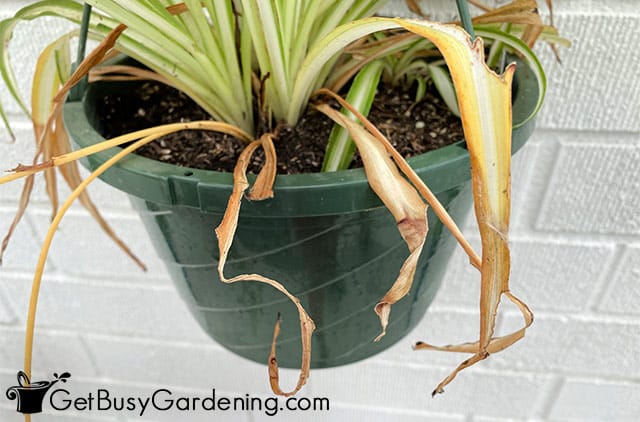
Spider Plant Watering Techniques
When it’s time to give your spider plant a drink, there are two different methods you can use – watering either from the top or the bottom.
Here I will explain both techniques and the pros and cons of each so you can choose the best option for your plant.
Top Watering Airplane Plants
To water spider plants from the top, pour it slowly over the soil until you see it pooling on the surface or running out of the bottom drainage holes.
Don’t pour it over the top of the plant, it’s best to avoid wetting the foliage, especially indoors.
It’s very important to allow all the excess to drain away and to empty the drip tray before replacing the pot to ensure your plant is never soaking.
This is the method I recommend, as it is the safest way to avoid overwatering.
Bottom Watering Spider Plants
Bottom watering involves filling the drip tray and allowing the roots to soak it up through the holes in the bottom of the pot.
I don’t recommend using this technique regularly for your spider plants, because it makes it very hard to tell if you are overwatering.
The top of the soil might feel dry, but the rootball itself may be saturated, making it likely you’ll give your plant more moisture than it needs.
The only exception is if your spider plant is very dehydrated and the water runs quickly through the pot, with little soaking in.
Bottom watering can help drench the soil in this situation, so it can retain moisture again. But use this method sparingly.
Related Post: Collecting and Sowing Spider Plant Seeds
FAQs
Here are the most common questions I’m asked about watering spider plants. If you don’t see yours listed here, please add it to the comments section below.
Should I water my spider plant from the top or bottom?
I recommend watering your spider plant from the top rather than the bottom. This is the safest method to use, as it avoids soaking the roots, and prevents overwatering.
How do I know when to water my spider plant?
The best way to tell when to water your spider plant is to check how wet or dry the soil is, either using your finger or a moisture probe. It is ready for a drink when the top 1-2 inches are dry, or when the gauge shows a reading of around 2 to 3.
What is the best way to water spider plants?
The best way to water a spider plant is to pour it slowly over the surface of the soil and allow any excess to drain through the holes in the bottom of the pot. You should then dump the excess from the drip tray before returning the pot.
Can a spider plant go 2 weeks without water?
A spider plant can go 2 weeks without water, and sometimes even longer, but this depends on factors like humidity, temperature, and location. In hot, sunny weather it may need watering more often, so it’s important to regularly check the moisture level to ensure it’s not drying out too much.
Do spider plants like to be wet?
Spider plants do not like to be wet. Instead, they prefer to stay consistently moist. Too much water will eventually cause root rot, and can end up killing the plant.
How much water does a spider plant need?
Exactly how much water a spider plant needs depends on various factors, from its size and location, to the temperature and time of year. The safest option is to check the soil regularly and only water when the top 1-2 inches are dry.
If you want to learn all there is to know about maintaining healthy indoor plants, then you need my Houseplant Care eBook. It will show you everything you need to know about how to keep every plant in your home thriving. Download your copy now!
More About Watering Plants
Share your tips for how to water spider plants in the comments section below.
Step By Step Instructions
How To Water A Spider Plant
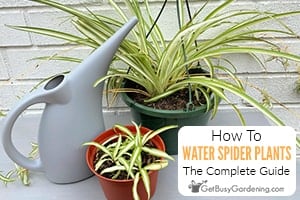
Learn how to water your spider plant. Discover my tips for success, including the best techniques, types of water to use, and how to spot the signs of over and under watering.
Materials
- Tepid rainwater or distilled
Instructions
- Check the moisture level - Push your finger into the soil or use a moisture gauge. If the top 1-2 inches are dry, or the gauge shows a reading of around 2 to 3, it's time to give your spider plant a drink.

- Water from the top - Slowly pour water directly onto the soil until you can see it pooling on the surface or flowing through the holes at the bottom of the pot.

- Allow excess to drain - Make sure all of the excess water drains away through the bottom holes.

- Dump the drip tray - Empty the drip tray before replacing the pot to avoid soaking your plant in water.
Notes
- Always make sure to check the moisture level before watering, the soil should feel dry 1-2” deep, and never be wet or soggy.
- Never leave your spider plant soaking in water or it could cause root rot.
- Spider plants are very sensitive to chemicals and salts found in tap water, so it’s best to use either distilled or rainwater.

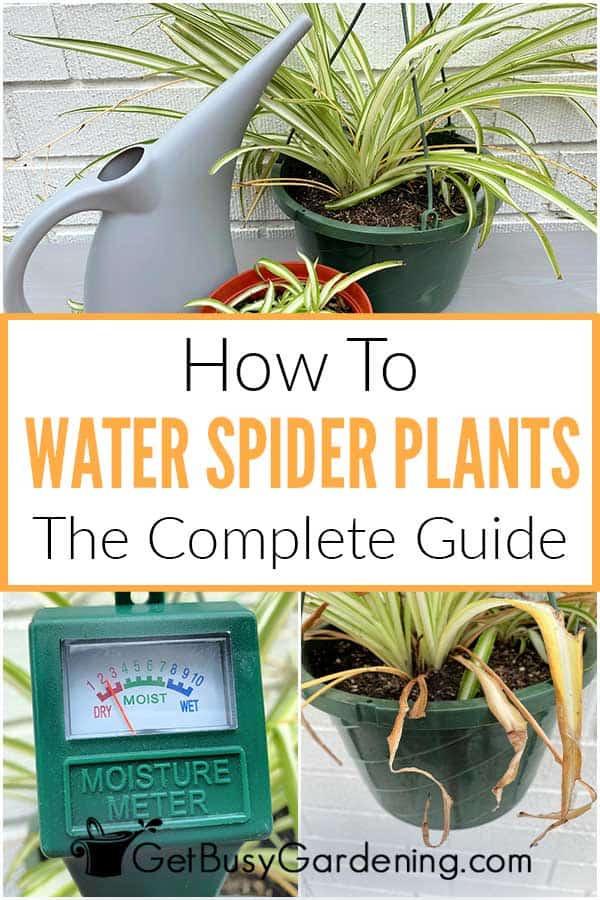


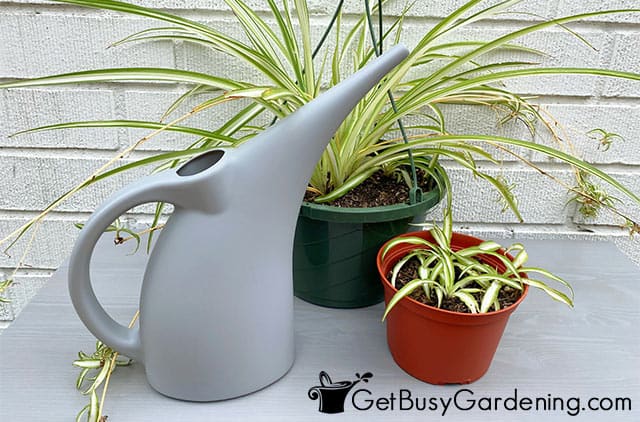
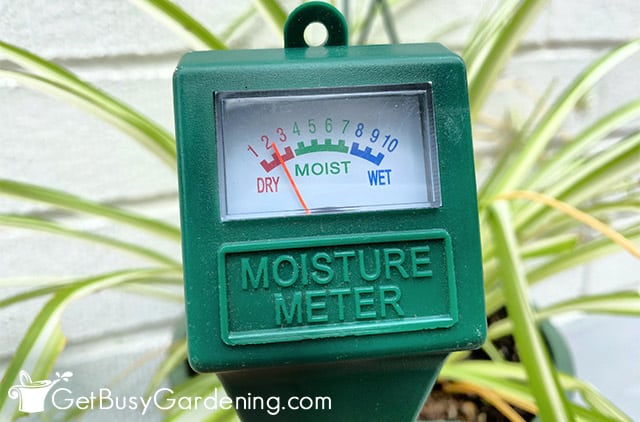

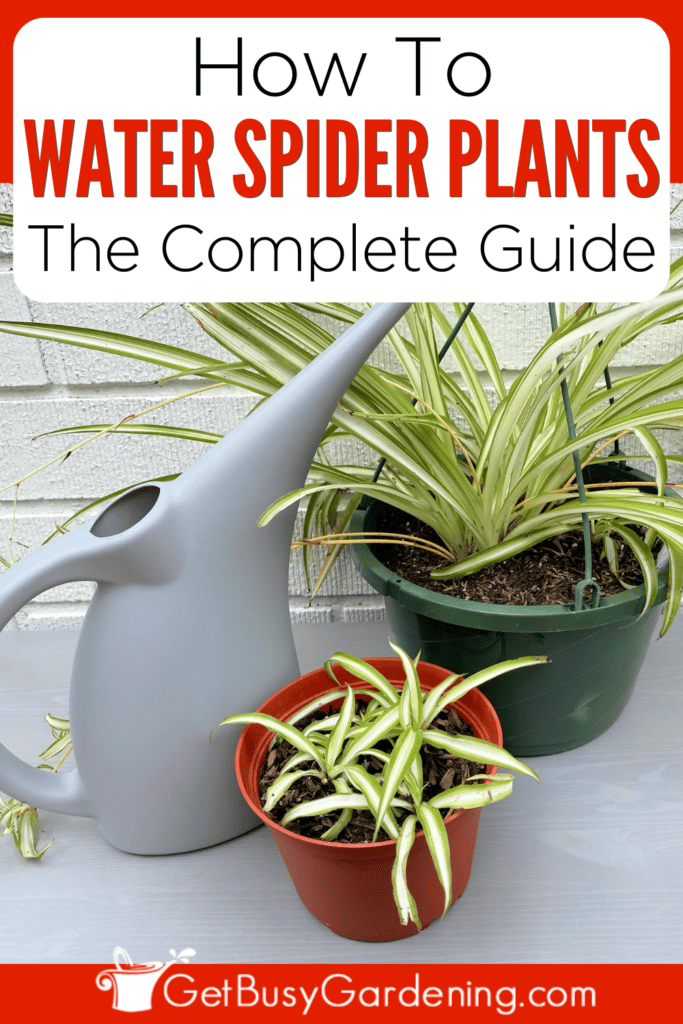
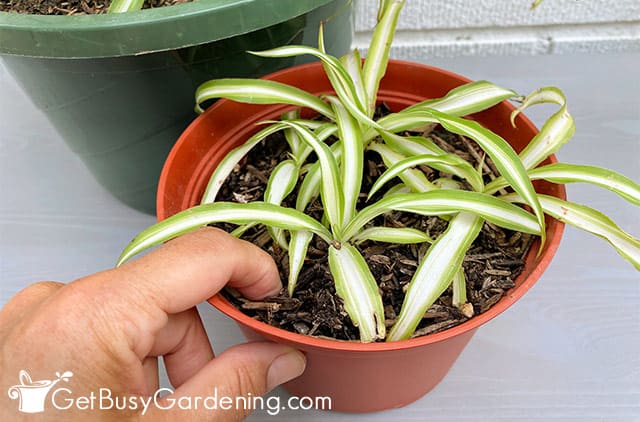
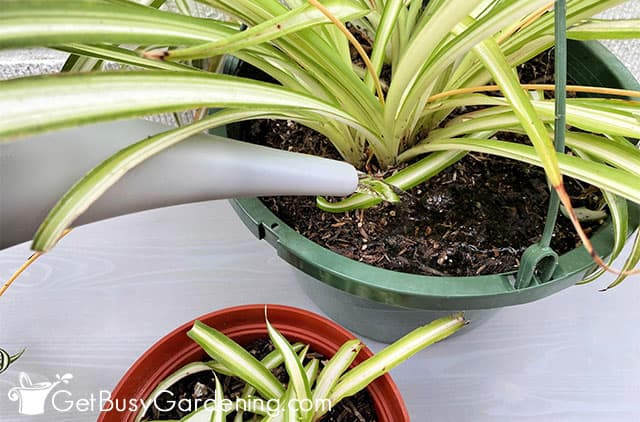


Michael Chang says
Can I water spider Plant from the bottom. I watered my orchid this way and the blooms lasted for over a year. My sanseveria was happy and produced lots of leaves.
Amy Andrychowicz says
You could certainly water your spider plant from the bottom if that’s what you prefer. However take great care to make sure you’re not giving it too much. The risk of bottom-watering is that the top of the soil can feel dry even if the roots are wet, so it’s difficult to tell when the plant needs more without overdoing it.